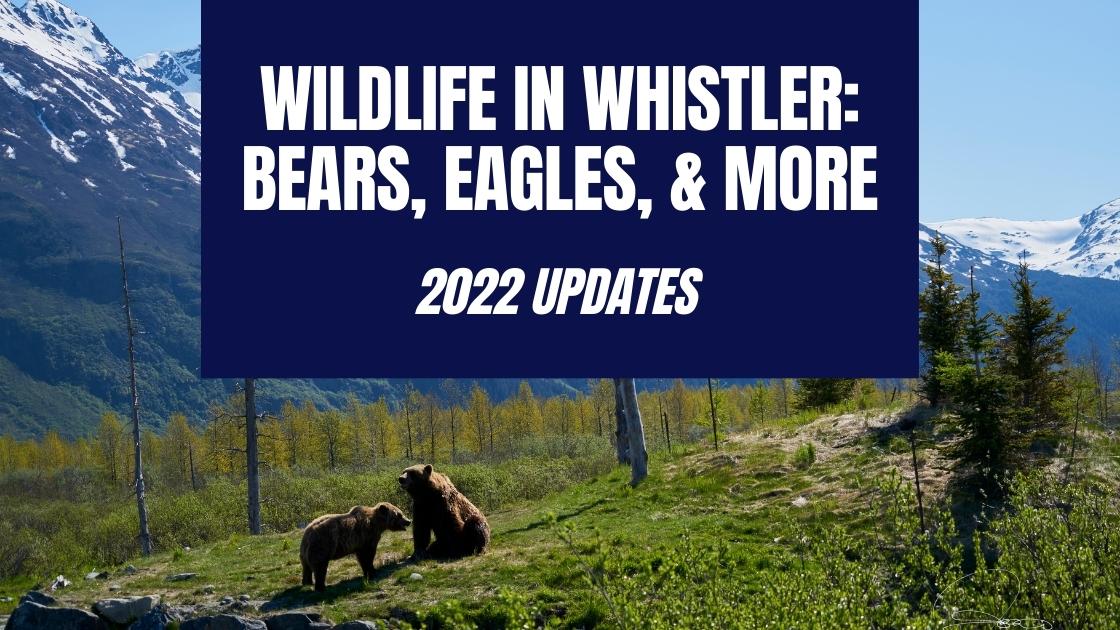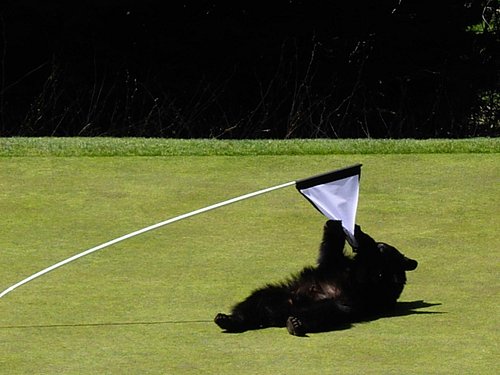Wildlife in Whistler: Bears, Eagles & More (2022 Updates)

No summer trip to Canada would be complete without seeing a wild animal of some sort, and in Whistler, our animal is the black bear. While there are opportunities to come across them by chance, taking a Whistler bear tour is an almost guaranteed way to see bears in BC.
You’ve seen them on TV and on the internet, but how about seeing a black bear in real life, during your next trip to Whistler!
Whistler Bears: Black and Grizzly
There are two types of bear species found in Whistler: black bears and grizzly bears, and it’s sometimes difficult to tell them apart. However, there are a few differences that can help distinguish between the two.
One of the main differences between the two types of bear is their size, with grizzly bears being larger. Black bears usually weigh in at around 150-600 pounds, whereas grizzly bears are much larger and weigh around 400-1000 pounds.
Other differences include face shape, with black bears having long, pointed faces and grizzlies having dish-shaped faces. Black bears also have tall, pointed ears, whereas grizzly bears tend to have short, round ears. Grizzly bears also have a noticeable shoulder hump that is not seen on black bears.
5 Rules for Bear Safety in Whistler
Wildlife sightings should happen naturally – there’s no sign of a zoo anywhere in Whistler and there never will be! Wildlife, no matter where in the world, should be respected and given a wide berth so they can stay just that – wild.
Here are five bear safety rules you should always remember:
1.Always carry bear spray. Bear spray is to be used defensively, to stop a charging or attacking bear. Remember, bear spray should only be used as a last resort.
Hold the bear spray with both hands, one on the can and the other on the trigger. Wait for the bear to be within 30 feet, aim downwards, and discharge the full contents of the can. Spray from side to side creating a cloud between yourself and the bear. If the bear continues to charge, aim for its face.When the bear stops its charge, it is time to leave the area swiftly.
2. Black Bear or Grizzly? Make sure you’re able to identify the difference between bear species. Know your black bears from your grizzly bears as they require different reactions in the case of an attack.
3. Bear attacks are rare, but here’s what to do in the unlikely event one should occur:
- Grizzly Bears: If attacked by a grizzly and wearing a pack, keep your pack on. Play dead, laying on the ground on your stomach with your hands behind your head. Spread your legs wide in order to make it more difficult for the bear to turn you over, and remain still until the bear leaves the area. If the attack persists, then fight back vigorously aiming all blows to the face.
- Black Bears: In the case of an attack by a black bear, do not play dead. If wearing a pack, drop it and try to escape to a secure place like a building or car. If escape is not possible, fight back using objects and concentrating blows to the bear’s face and muzzle.
4. Be bear safe in Whistler. When visiting Whistler, it is easy to forget that it is home to countless black bears and the occasional grizzly. It is important to remember to bear-proof homes or holiday rentals and to get rid of any attractants. Close and lock all bear-accessible windows and doors to both houses and cars, and don’t forget to keep all trash indoors or in locked garages and sheds that are not accessible to bears.
5. Be bear smart when camping. It is important not to attract bears to the area in which you will be sleeping. Do not cook or eat food in your tent; don’t keep any food in the tent; and remember to clean dirty dishes and cutlery that may be stored in or around your tent. Most importantly, carefully store your food. There are a few different ways to do this, from bear canisters and bear bags to properly hanging your food from trees or poles.
The Big Bad Bear-Watching Tour
The best way to see bears in BC is with Whistler bear tours. Comfortable Jeeps will take you to prime bear-viewing locations where you can safely watch bears in their natural habitat. It’s the perfect activity to do, rain or shine, as the bears don’t mind a bit of wet weather and will be out and about regardless.
What to Expect
If you’re looking to get out of Whistler Village and into the wild—in style—then this is the trip for you. This intimate excursion focuses on the resident black bears and cubs found in the Whistler Olympic Park area, while also providing a look at the infamous 2010 Winter Olympics venue.
Enjoy a host of special privileges with after-hours access, a drive along the 2010 Olympic legacy Cross Country Trail network as well as a once-in-a-lifetime view from atop the Whistler Olympic ski jumps.
Get up close and observe bears like you never have before, from a safe distance in the comfort and safety of a luxury Jeep. Along this trip, you will also get the opportunity to see some of Whistler’s iconic landmarks like Alexander Falls and Black Tusk.
What to Bring
Be sure to pack your camera to capture these magnificent animals in their natural habitat—this is an experience you will not want to forget. You will also need to bring hiking gear suitable for the weather conditions. Last but not least, be sure to bring positive energy and a healthy respect for nature.
When Can You See Bears in Whistler?
The best time to see bears is usually between early May and early August. Bears can be found foraging for fruit, berries, seeds, and nuts amongst a whole host of other food sources as they put on weight ready for winter hibernation.
5 Alternative Ways to See Bears in Whistler
1. Peak 2 Peak 360 Experience
Black bears love to graze on the lush grassy slopes of Whistler and Blackcomb Mountains and, luckily, you can view from above as you travel on the Whistler Village Gondola or Blackcomb Gondola towards the top. Keep your eyes peeled for the large bruins that can vary in colour from black to a cinnamon brown. Despite how big they are, they’re easily mistaken for tree stumps and camouflaged in the dark forests.
Deer can also be seen grazing along the slopes and often travel in groups, though, like the bears, they camouflage really well in the forest. While hiking the alpine trails on Whistler or Blackcomb, listen for the shrill squeak of a pika or the squeal of a marmot. Whiskey jacks love to chatter overhead in the alpine (hold on to your snacks!) while the eerie caw of ravens echo through the valley.
2. Or . . . Golfing

It’s true, Whistler’s resident bears love to hang out on the local golf course.
Black bears love golf courses! The succulent grasses, dandelions, and generally quiet surroundings make them the perfect places for bears to hang out. Book a tee time at one of the three golf courses in town and you may well see one of the freeloaders as you play.
Do not let bear watching interrupt your play, and don’t even think about walking onto the course if you haven’t paid your green fee – leave these majestic beasts in peace. Some of the courses have viewpoints along the Valley Trail, so if you’re walking or biking alongside it, you might get lucky. But they do tend to retreat deep within the course.
3. Whistler Bike Park
For those looking to take it up a notch, downhill mountain biking in the Whistler Bike Park is a great way to experience Whistler’s most popular summer sport. Take a lesson with a certified mountain bike guide or explore the trails on your own, though it is recommended that first timer’s to go up with a guide.
Black bears and deer love to graze on the grassy mountainside and can often be seen hanging out alongside the trails. They are usually focused on eating and relaxing so don’t get intentionally close – they’re quite used to the mountain bikers zooming by, and if you don’t bother them, they won’t bother you!
4. Hiking in the Backcountry
If you are looking to explore the vast mountain areas surrounding Whistler, then hiking in the backcountry is a great way to see Canadian wildlife in its natural habitat—and you might see a bear or two. Whether you’re enjoying the wonderful sight of wildflowers in full bloom surrounding Rainbow Lake or taking in the jaw-dropping views at Panorama Ridge, be on the lookout for wildlife.
Don’t forget, when in the backcountry, take your ‘bear smart’ principles with you. Always carry bear spray and keep it within reach at all times during your trek, and make sure to keep food far away from camp. While hiking through the backcountry, it is also good to make lots of noise to warn bears or other wildlife of your presence. Bear bells can be very useful for this.
5. Walking or Biking the Valley Trail
With all of the adventurous activities to do in Whistler, sometimes a light stroll or bike along the Valley Trail is a perfect way to spend your day. The Whistler Valley Trail spans a massive 40 kilometres, connecting Whistler neighbourhoods from Function Junction to Emerald and everything in between.
It is estimated that approximately 50 black bears make their home in the surrounding forests and mountains of Whistler. This means that on your journey along the Valley Trail, you might be lucky enough come across one. If you do have an encounter with a bear on the Valley Trail, be sure to give it plenty of room and don’t get too close. Choose an alternative route if the bear is blocking the trail.
What Other Animals to Expect in Whistler?
Whistler is home to numerous wild animals, and while many are elusive, there are some animals in Whistler you just might see during your trip.
Hoary Marmots
They are Whistler’s namesake – the town is named after the shrill whistles heard throughout the alpine by these noisy, furry creatures. The hoary marmot is a large, bulky ground squirrel with short, heavy limbs and a broad head.
They’re often seen on summer hikes in the alpine, sunning themselves on boulders but keeping a key eye out for danger. They blend in well with their surroundings and don’t move incredibly fast, but you’ll only be able to see them in summer as they hibernate during the winter.
Deer
When riding up the gondola, you might just spot a few deer munching on the grass down below. They tend to be quite shy and like to hang out on the mountain and stay out of the village area. When hiking or biking, you might see them next to the trail, but they’re very skittish. You might be wondering why deer would hang out in an area frequented by black bears, but they don’t seem to mind and live harmoniously together.
Whiskey Jacks
Whiskey Jacks, otherwise known as Gray Jays, are very frequently spotted year-round in the alpine. They’re notorious at the Harmony and Symphony ski lift lines hoping to snag a piece of someone’s granola bar or trail mix – but do resist as it does interfere with the ecosystem and can make the birds ill. Simply hold out your hand or ski pole and one might stop by for a brief moment.
Steller’s Jay
A very common bird in the Whistler area, the steller’s jay is also one of the prettiest birds to be seen. With it’s brilliant blue and grey coloured feathers, it is difficult to miss.
Cougars
These wild cats are rarely seen but live among the mountains of Whistler. Although it is unlikely you will encounter any cougars in Whistler, you can be sure they might see you as they remain hidden in the surrounding landscape.
Bald Eagles
These majestic birds of prey are recognizable for their brown body and wings, white head and tail, and yellow, hooked beak. Keep your eyes peeled for these predatory raptors high in the mountain tops or lurking for prey in nearby rivers.
Beavers
One of Canada’s most iconic creatures can be found in Whistler, swimming in the lakes and rivers and building dams along the waterways. You’ll often see them during a sunset paddleboard session on Alpha Lake or along the River of Golden Dreams. The beaver works as a keystone species in an ecosystem by creating wetlands that are used by other animals. Beavers do not hibernate and stay cosy in their lodges throughout the winter before reemerging once the lakes and rivers melt again.
Pika
Another squeaky and super cute rodent often seen (and heard) in Whistler is the pika. They’re found in boulder fields in the mountains and in the valley and have a very distinguishable sound. They look like a mix between a rabbit and a hamster, with a small, fluffy body and short, rounded ears. They spend the summers gathering food to eat during the winter as they do not hibernate. Often where you’ll see a marmot is where you’ll find pika as well!
Well Worth the Attention: Wildlife in Whistler
Seeing a bear is a highlight of any visitor’s trip to Whistler, so why miss the chance when you could partake in Whistler bear tours to get up close and personal with these famous residents. Not only will you capture tons of photo and video footage, you’ll also learn all about them from professional guides who can answer all your burning questions.
If you’re leaving it to chance – best of luck, you just might see one when you least expect it.
